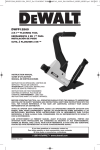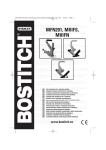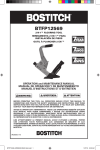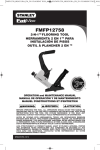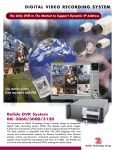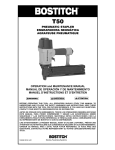Download Bostitch MIIIFS Specifications
Transcript
BOSTITCH ® MIIIFS / MIIIFN FLOORING TOOLS HERRAMIENTAS DE PISOS CLOUEURS DE PLANCHER OPERATION and MAINTENANCE MANUAL MANUAL DE OPERACIÓN Y DE MANTENIMIENTO MANUEL D’INSTRUCTIONS ET D’ENTRETIEN BEFORE OPERATING THIS TOOL, ALL OPERATORS SHOULD STUDY THIS MANUAL TO UNDERSTAND AND FOLLOW THE SAFETY WARNINGS AND INSTRUCTIONS. KEEP THESE INSTRUCTIONS WITH THE TOOL FOR FUTURE REFERENCE. IF YOU HAVE ANY QUESTIONS, CONTACT YOUR STANLEY-BOSTITCH REPRESENTATIVE OR DISTRIBUTOR. ANTES DE OPERAR ESTA HERRAMIENTA, TODOS LOS OPERADORES DEBERÁN ESTUDIAR ESTE MANUAL PARA PODER COMPRENDER Y SEGUIR LAS ADVERTENCIAS SOBRE SEGURIDAD Y LAS INSTRUCCIONES. MANTENGA ESTAS INSTRUCCIONES CON LA HERRAMIENTA PARA FUTURA REFERENCIA, SI TIENE ALGUNA DUDA, COMUNÍQUESE CON SU REPRESENTANTE DE STANLEY-BOSTITCH O CON SU DISTRIBUIDOR. LIRE ATTENTIVEMENT LE PRÉSENT MANUEL AVANT D’UTILISER L’APPAREIL. PRÉTER UNE ATTENTION TOUTE PARTICULIÈRE AUX CONSIGNES DE SÉCURITÉ ET AUX AVERTISSEMENTS. GARDER CE MANUEL AVEC L’OUTIL POUR FUTUR RÉFÉRENCE. SI VOUS AVEZ DES QUESTIONS, CONTACTEZ VOTRE REPRÉSENTANT OU VOTRE CONCESSIONNAIRE STANLEY-BOSTITCH. BOSTITCH ® 103697REVD 5/99 Stanley Fastening Systems INTRODUCTION The Stanley-Bostitch MIII is a precision-built tool, designed for high speed, high volume fastening. These tools will deliver efficient, dependable service when used correctly and with care. As with any fine power tool, for best performance the manufacturer’s instructions must be followed. Please study this manual before operating the tool and understand the safety warnings and cautions. The instructions on installation, operation and maintenance should be read carefully, and the manual kept for reference. NOTE: Additional safety measures may be required because of your particular application of the tool. Contact your Stanley-Bostitch representative or distributor with any questions concerning the tool and its use. Stanley-Bostitch, Inc., East Greenwich, Rhode Island 02818. INDEX Safety Instructions . . . . . . . . . . . . . . . . . . . . . . . . . . . . . . . . . . . . . . . . . . . 3 Tool Specifications . . . . . . . . . . . . . . . . . . . . . . . . . . . . . . . . . . . . . . . . . . 4 Air Supply: Fittings, Hoses, Filters, Air Consumption, Regulators, Operating Pressure, Setting Correct Pressure . . . . . . . . . . . . . . . . . . . . . . 5 Lubrication . . . . . . . . . . . . . . . . . . . . . . . . . . . . . . . . . . . . . . . . . . . . . . . . 5 Loading the Tool . . . . . . . . . . . . . . . . . . . . . . . . . . . . . . . . . . . . . . . . . . . . 6 Tool Operation . . . . . . . . . . . . . . . . . . . . . . . . . . . . . . . . . . . . . . . . 7, 8 & 9 Basic Tool Operation (diagram). . . . . . . . . . . . . . . . . . . . . . . . . . . . . . . . . . 9 Maintaining the Pneumatic Tool . . . . . . . . . . . . . . . . . . . . . . . . . . . . . . . . . 9 Trouble Shooting . . . . . . . . . . . . . . . . . . . . . . . . . . . . . . . . . . . . . . . . . . 10 Maintaining the MIII Series Tools. . . . . . . . . . . . . . . . . . . . . . . . . . . . . . . . 11 Accessories . . . . . . . . . . . . . . . . . . . . . . . . . . . . . . . . . . . . . . . . . . . . . . 12 NOTE: Stanley-Bostitch tools have been engineered to provide excellent customer satisfaction and are designed to achieve maximum performance when used with precision Stanley-Bostitch fasteners engineered to the same exacting standards. Stanley-Bostitch cannot assume responsibility for product performance if our tools are used with fasteners or accessories not meeting the specific requirements established for genuine Stanley-Bostitch nails, staples and accessories. PROTECT YOUR TOOLS USE ONLY GENUINE ® FASTENERS LIMITED WARRANTY Stanley-Bostitch, Inc., warrants to the original retail purchaser that this product is free from defects in material and workmanship, and agrees to repair or replace, at Stanley-Bostitch's option, any defective product within 1 year from the date of purchase This warranty. is not transferable. It only covers damage resulting from defects in material or workmanship, and it does not cover conditions or malfunctions resulting from normal wear, neglect, abuse, accident or repairs attempted or made by other than our regional repair center or authorized warranty service center. Driver blades, bumpers and o-rings are considered normally wearing parts. THIS WARRANTY IS IN LIEU OF ALL OTHER EXPRESS WARRANTIES. ANY WARRANTY OF MERCHANTABILITY OR FITNESS FOR A PARTICULAR PURPOSE IS LIMITED TO THE DURATION OF THIS WARRANTY. STANLEY-BOSTITCH SHALL NOT BE LIABLE FOR ANY INCIDENTAL OR CONSEQUENTIAL DAMAGES. This warranty is limited to sales in the United States and Canada. Some states do not allow limitations on how long an implied warranty lasts, or the exclusion or limitation of incidental or consequential damages, so the above limitations or exclusions may not apply to you. This warranty gives you specific legal rights, and you may also have other rights which vary from state to state. To obtain warranty service, return the product at your expense together with proof of purchase to a Stanley-Bostitch Regional or authorized warranty repair center. You may call us at 1-800-556-6696 for the location of authorized warranty service centers in your area. -2- SAFETY INSTRUCTIONS EYE PROTECTION which conforms to ANSI specifications and provides protection against flying particles both from the FRONT and SIDE should ALWAYS be worn by the operator and others in the work area when loading, operating or servicing this tool. Eye protection is required to guard against flying fasteners and debris, which could cause severe eye injury. The employer and/or user must ensure that proper eye protection is worn. Eye protection equipment must conform to the requirements of the American National Standards Institute, ANSI Z87.1-1989 and provide both frontal and side protection. NOTE: Non-side shielded spectacles and face shields alone do not provide adequate protection. CAUTION: ADDITIONAL SAFETY PROTECTION will be required in some environments. For example, the working area may include exposure to noise level which can lead to hearing damage. The employer and user must ensure that any necessary hearing protection is provided and used by the operator and others in the work area. Some environments will require the use of head protection equipment. When required, the employer and user must ensure that head protection conforming to ANSI Z89.1 1986 is used. AIR SUPPLY AND CONNECTIONS Do not use oxygen, combustible gases, or bottled gases as a power source for this tool as tool may explode, possibly causing injury. Do not use supply sources which can potentially exceed 200 P.S.I.G. as tool may burst, possibly causing injury. The connector on the tool must not hold pressure when air supply is disconnected. If a wrong fitting is used, the tool can remain charged with air after disconnecting and thus will be able to drive a fastener even after the air line is disconnected possibly causing injury. Do not pull trigger or depress contact arm while connected to the air supply as the tool may cycle, possibly causing injury. Always disconnect air supply: 1.) Before making adjustments; 2.) When servicing the tool; 3.) When clearing a jam; 4.) When tool is not in use; 5.) When moving to a different work area, as accidental actuation may occur, possibly causing injury. LOADING TOOL When loading tool: 1.) Never place a hand or any part of body in fastener discharge area of tool; 2.) Never point tool at anyone; 3.) Do not pull the trigger or depress the trip as accidental actuation may occur, possibly causing injury. OPERATION Always handle the tool with care: 1.) Never engage in horseplay; 2.) Never pull the trigger unless nose is directed toward the work; 3.) Keep others a safe distance from the tool while tool is in operation as accidental actuation may occur, possibly causing injury. The operator must not hold the trigger pulled on contact arm tools except during fastening operation as serious injury could result if the trip accidentally contacted someone or something, causing the tool to cycle. Keep hands and body away from the discharge area of the tool. A contact arm tool may bounce from the recoil of driving a fastener and an unwanted second fastener may be driven possibly causing injury. Check operation of the contact arm mechanism frequently. Do not use the tool if the arm is not working correctly as accidental driving of a fastener may result. Do not interfere with the proper operation of the contact arm mechanism. Do not drive fasteners on top of other fasteners or with the tool at an overly steep angle as this may cause deflection of fasteners which could cause injury. Do not drive fasteners close to the edge of the work piece as the wood may split, allowing the fastener to be deflected possibly causing injury. MAINTAINING THE TOOL When working on air tools note the warnings in this manual and use extra care when evaluating problem tools. -3- MIII TOOL SPECIFICATIONS All screws and nuts are english. MODEL LENGTH HEIGHT WIDTH WEIGHT MIIIFS 17-1/4” (438mm) 11-1/2” (292mm) 3-1/8” (80mm) 11.2lbs (5.1kg) MIIIFN 17-1/4” (438mm) 11-1/2” (292mm) 3-1/8” (80mm) 11.2lbs (5.1kg) FASTENER SPECIFICATIONS: MODEL FASTENER CROWN WIDTH WIRE SIZE MAX LENGTH MIIIFS BCS1500 1/2” (13mm) 15-1/2 Ga. 2” (50mm) MIIIFN FLN-200 - - 2” (50mm) TOOL AIR FITTING: This tool uses a 3/8” N.P.T. male plug. The inside diameter should be .275” (7mm) or larger. The fitting must be capable of discharging tool air pressure when disconnected from the air supply. OPERATING PRESSURE: 70 to 90 p.s.i.g. (4.9 to 6.3 kg/cm2). Select the operating pressure within this range for best fastener performance. DO NOT EXCEED THIS RECOMMENDED OPERATING PRESSURE. AIR CONSUMPTION: The MIII requires 4.2 cubic feet per minute (221 liters per minute) of free air to operate at the rate of 60 fasteners per minute, at 80 p.s.i. (5.6 kg/cm2). Take the actual rate at which the tool will be run to determine the amount of air required. For instance, if your fastener usage averages 30 fasteners per minute, you need 50% of the tool’s c.f.m. of free air which is required to operate the tool at 60 fasteners per minute. OPERATION Caution Regarding Use of this Tool to Install Pre-finished Flooring This MarkIII Flooring Tool was designed for use in installing unfinished hardwood flooring. It can be used to install pre-finished flooring however caution must be used to ensure that the finish is not damaged by the tool. It is recommended that the tool be tested on a sample section to be certain that the tool and technique of use do not leave marks on the finish. This procedure should be followed before each job due to variations in flooring and tool condition. -4- AIR SUPPLY AND CONNECTIONS Do not use oxygen, combustible gases, or bottled gases as a power source for this tool as tool may explode, possibly causing injury. FITTINGS: Install a male plug on the tool which is free flowing and which will release air pressure from the tool when disconnected from the supply source. HOSES: Air hoses should have a minimum of 150 p.s.i. (10.6 kg/cm2) working pressure rating or 150 percent of the maximum pressure that could be produced in the air system. The supply hose should contain a fitting that will provide “quick disconnecting” from the male plug on the tool. SUPPLY SOURCE: Use only clean regulated compressed air as a power source for this tool. NEVER USE OXYGEN, COMBUSTIBLE GASES, OR BOTTLED GASES, AS A POWER SOURCE FOR THIS TOOL AS TOOL MAY EXPLODE. REGULATOR: A pressure regulator with an operating pressure of 0 - 125 p.s.i. (0 - 8.79 KG/CM2) is required to control the operatiing pressure for safe operation of this tool. Do not connect this tool to air pressure which can potentially exceed 200 p.s.i. (14 KG/CM2)as tool may fracture or burst, possibly causing injury. OPERATING PRESSURE: Do not exceed recommended maximum operating pressure as tool wear will be greatly increased. The air supply must be capable of maintaining the operating pressure at the tool. Pressure drops in the air supply can reduce the tool’s driving power. Refer to “TOOL SPECIFICATIONS” for setting the correct operating pressure for the tool. FILTER: Dirt and water in the air supply are major causes of wear in pneumatic tools. A filter will help to get the best performance and minimum wear from the tool. The filter must have adequate flow capacity for the specific installation. The filter has to be kept clean to be effective in providing clean compressed air to the tool. Consult the manufacturer’s instructions on proper maintenance of your filter. A dirty and clogged filter will cause a pressure drop which will reduce the tool’s performance. LUBRICATION Frequent, but not excessive, lubrication is required for best performance. Oil added through the air line connection will lubricate the internal parts. Use STANLEY-BOSTITCH Air Tool Lubricant, Mobil Velocite #10, or equivalent. Do not use detergent oil or additives as these lubricants will cause accelerated wear to the seals and bumpers in the tool, resulting in poor tool performance and frequent tool maintenance. If no airline lubricator is used, add oil during use into the air fitting on the tool once or twice a day. Only a few drops of oil at a time is necessary. Too much oil will only collect inside the tool and will be noticeable in the exhaust cycle. COLD WEATHER OPERATION: For cold weather operation, near and below freezing, the moisture in the air line may freeze and prevent tool operation. We recommend the use of STANLEY-BOSTITCH WINTER FORMULA air tool lubricant or permanent antifreeze (ethylene glycol) as a cold weather lubricant. CAUTION: Do not store tools in a cold weather environment to prevent frost or ice formation on the tools operating valves and mechanisms that could cause tool failure. NOTE:Some commercial air line drying liquids are harmful to “O”-rings and seals – do not use these low temperature air dryers without checking compatibility. -5- LOADING THE MIII EYE PROTECTION which conforms to ANSI specifications and provides protection against flying particles both from the FRONT and SIDE should ALWAYS be worn by the operator and others in the work area when loading, operating or servicing this tool. Eye protection is required to guard against flying fasteners and debris, which could cause severe eye injury. The employer and/or user must ensure that proper eye protection is worn. Eye protection equipment must conform to the requirements of the American National Standards Institute, ANSI Z87.1-1989 and provide both frontal and side protection. NOTE: Non-side shielded spectacles and face shields alone do not provide adequate protection. TO PREVENT ACCIDENTAL INJURIES: • Never place a hand or any other part of the body in nail discharge area of tool while the air supply is connected. • Never point the tool at anyone else. • Never engage in horseplay. • Never pull the trigger unless nose is directed at the work. • Always handle the tool with care. • Do not pull the trigger or depress the trip mechanism while loading the tool. MIIIFS STAPLE LOADING: Pull cover open. Insert stick of staples. Push cover forward until the detent pin snaps into place, locking the cover. The tool is now ready to operate. MIIIFN NAIL LOADING: Insert nails. Pull pusher assembly back to engage pusher to strip of nails. Tool is now ready to operate. NOTE: Use only fasteners recommended for use in Bostitch MIII series models. -6- TOOL OPERATION EYE PROTECTION which conforms to ANSI specifications and provides protection against flying particles both from the FRONT and SIDE should ALWAYS be worn by the operator and others in the work area when loading, operating or servicing this tool. Eye protection is required to guard against flying fasteners and debris, which could cause severe eye injury. The employer and/or user must ensure that proper eye protection is worn. Eye protection equipment must conform to the requirements of the American National Standards Institute, ANSI Z87.1-1989 and provide both frontal and side protection. NOTE: Non-side shielded spectacles and face shields alone do not provide adequate protection. BEFORE HANDLING OR OPERATING THIS TOOL: I. READ AND UNDERSTAND THE WARNINGS CONTAINED IN THIS MANUAL. II. REFER TO “TOOL SPECIFICATIONS” IN THIS MANUAL TO IDENTIFY THE OPERATING SYSTEM ON YOUR TOOL. -7- IN ADDITION TO THE OTHER WARNINGS CONTAINED IN THIS MANUAL OBSERVE THE FOLLOWING FOR SAFE OPERATION • Use the STANLEY-BOSTITCH pneumatic tool only for the purpose for which it was designed. • Never use this tool in a manner that could cause a fastener to be directed toward the user or others in the work area. • Do not use the tool as a hammer. • Always carry the tool by the handle. Never carry the tool by the air hose. • Do not alter or modify this tool from the original design or function without approval from STANLEY-BOSTITCH, INC. • Always be aware that misuse and improper handling of this tool can cause injury to yourself and others. • Never clamp or tape the trigger or contact trip in an actuated position. • Never leave a tool unattended with the air hose attached. • Do not operate this tool if it does not contain a legible WARNING LABEL. • Do not continue to use a tool that leaks air or does not function properly. Notify your nearest Stanley-Bostitch representative if your tool continues to experience functional problems. -8- MAINTAINING THE PNEUMATIC TOOL When working on air tools, note the warnings in this manual and use extra care evaluating problem tools. CAUTION: Pusher spring (constant force spring). Caution must be used when working with the spring assembly. The spring is wrapped around, but not attached to, a roller. If the spring is extended beyond its length, the end will come off the roller and the spring will roll up with a snap, with a chance of pinching your hand. Also the edges of the spring are very thin and could cut. Care must also be taken to insure no permanent kinks are put in the spring as this will reduce the springs force. REPLACEMENT PARTS: STANLEY-BOSTITCH replacement parts are recommended. Do not use modified parts or parts which will not give equivalent performance to the original equipment. ASSEMBLY PROCEDURE FOR SEALS: When repairing a tool, make sure the internal parts are clean and lubricated. Use Parker “O”-LUBE or equivalent on all “O”-rings. Coat each “O”-ring with “O”-LUBE before assembling. Use a small amount of oil on all moving surfaces and pivots. After reassembly add a few drops of STANLEY-BOSTITCH Air Tool Lubricant through the air line fitting before testing. AIR SUPPLY-PRESSURE AND VOLUME: Air volume is as important as air pressure. The air volume supplied to the tool may be inadequate because of undersize fittings and hoses, or from the effects of dirt and water in the system. Restricted air flow will prevent the tool from receiving an adequate volume of air, even though the pressure reading is high. The results will be slow operation, misfeeds or reduced driving power. Before evaluating tool problems for these symptoms, trace the air supply from the tool to the supply source for restrictive connectors, swivel fittings, low points containing water and anything else that would prevent full volume flow of air to the tool. -9- TROUBLE SHOOTING PROBLEM CAUSE Trigger valve housing leaks air Trigger valve stem leaks air Frame/nose leaks air O-ring cut or cracked . . . . . . . . . . . . . .Replace O-ring O-ring/seals cut or cracked . . . . . . . . .Replace trigger valve assembly Loose nose screws . . . . . . . . . . . . . . .Tighten and recheck O-ring or Gasket is cut or cracked . . . .Replace O-ring or gasket Bumper cracked/worn . . . . . . . . . . . . .Replace bumper Damaged gasket or seal . . . . . . . . . . .Replace gasket or seal Cracked/worn head valve bumper . . . .Replace bumper Loose cap screws . . . . . . . . . . . . . . . .Tighten and recheck Air supply restriction . . . . . . . . . . . . . . .Check air supply equipment Tool dry, lack of lubrication . . . . . . . . . .Use STANLEY-BOSTITCH Air Tool Lubricant Worn head valve O-rings . . . . . . . . . . .Replace O-rings Broken cylinder cap spring . . . . . . . . . .Replace cylinder cap spring Head valve stuck in cap . . . . . . . . . . . .Disassemble/Check/Lubricate Tool dry, lacks lubrication . . . . . . . . . . .Use STANLEY-BOSTITCH Air Tool Lubricant Broken cylinder cap spring . . . . . . . . . .Replace cap spring O-rings/seals cut or cracked . . . . . . . . .Replace O-rings/seals Exhaust blocked . . . . . . . . . . . . . . . . .Check bumper, head valve spring, muffler Trigger assembly worn/leaks . . . . . . . .Replace trigger assembly Dirt/tar build up on driver . . . . . . . . . . .Disassemble nose/driver to clean Cylinder sleeve not seated correctly on bottom bumper . . . . . . . . . . . . . . . .Disassemble to correct Head valve dry . . . . . . . . . . . . . . . . . . .Disassemble/lubricate Air pressure too low . . . . . . . . . . . . . . .Check air supply equipment Worn bumper . . . . . . . . . . . . . . . . . . . .Replace bumper Tar/dirt in driver channel . . . . . . . . . . . .Disassemble and clean nose and driver Air restriction/inadequate air flow through quick disconnect socket and plug . . . . .Replace quick disconnect fittings Worn piston O-ring . . . . . . . . . . . . . . . .Replace O-ring, check driver Tool dry, lacks lubrication . . . . . . . . . . .Use STANLEY-BOSTITCH Air Tool Lubricant Damaged pusher spring . . . . . . . . . . . .Replace spring Low air pressure . . . . . . . . . . . . . . . . .Check air supply system to tool Loose magazine nose screws . . . . . . .Tighten all screws Fasteners too short for tool . . . . . . . . .Use only recommended fasteners Bent fasteners . . . . . . . . . . . . . . . . . . .Discontinue using these fasteners Wrong size fasteners . . . . . . . . . . . . . .Use only recommended fasteners Leaking head cap gasket . . . . . . . . . . .Tighten screws/replace gasket Trigger valve O-ring cut/worn . . . . . . . .Replace O-ring Broken/chipped driver . . . . . . . . . . . . .Replace driver (check piston O-ring) Dry/dirty magazine . . . . . . . . . . . . . . . .Clean/lubricate use STANLEY-BOSTITCH Air Tool Lubricant Worn magazine . . . . . . . . . . . . . . . . . .Replace magazine Driver channel worn . . . . . . . . . . . . . . .Replace nose/check door Wrong size fasteners . . . . . . . . . . . . . .Use only recommended fasteners Bent fasteners . . . . . . . . . . . . . . . . . . .Discontinue using these fasteners Loose magazine/nose screws . . . . . . .Tighten all screws Broken/chipped driver . . . . . . . . . . . . .Replace driver Frame/cap leaks air Failure to cycle Lack of power; slow to cycle Skipping fasteners; intermittent feed Fasteners jam in tool CORRECTION COIL NAILERS Skipping fasteners; intermittent feed Fasteners jam in tool/canister Feed piston dry . . . . . . . . . . . . . . . . . .Add STANLEY-BOSTITCH Air Tool Lubricant in hole in feed piston cover Feed piston O-rings cracked/worn . . . .Replace O-rings/check bumper and spring. Lubricate assembly. Check Pawl binding . . . . . . . . . . . . . . .Inspect Pawl and spring on door. Must work freely. Canister bottom not set correctly . . . . .Set canister bottom for length of nails being used Broken weld wires in nail coil . . . . . . . .Remove coil of nails and use another coil Wrong size fasteners for tool . . . . . . . .Use only recommended fasteners/check canisterbottom adjustment Broken welded wires in nail coil . . . . . .Remove coil of nails and use another coil Wrong slide plate adjustment for wire/plastic collated nail coil . . . . . . . . .Adjust switch pins for wire/plastic collated nail coil -10- MAINTAINING THE MIII SERIES TOOLS TO REPLACE PISTON: a. b. c. Insert the flats on the lower end of the driver piston stem carefully into the end of piston and plunger wrench, BC1009. Using another special wrench, BC1009, or another wrench of the proper size, unscrew the plunger from the upper end of the stem. After this is done, it will be possible to lift the poppet off the stem. Place the special wrench, BC1009, down over the piston stem onto the driver piston, locking the piston ears in the slots in the wrench. Unscrew the piston from the stem. TO REPLACE DRIVER: a. b. c. d. e. It is not necessary to disassemble the piston-poppet-driver assembly to replace the driver. Pull the poppet up on the driver piston stem as far as it will go. Insert special wrench, BC1009, over the driver piston, locking the piston ears in the slots in the wrench. Unscrew the piston from threaded portion of the stem. To remove the driver blade from the piston stem, push the driver blade pin out of the stem. This will release the blade. Insert new driver blade into the slot in the end of the driver piston stem and assemble the driver blade pin. Test the side play in the driver blade by grasping the driver piston stem in one hand and the blade in the other and moving the blade sideways in alignment with the slot in the stem. There should be a small amount of side play in the blade. This is necessary to take care of any slight misalignment between the blade and guide in the nose. If there is no side play, the blade should be removed and the top (pin end) just barely dressed off with a stone. It is not necessary to do more than smooth off the top to get the necessary side play. Do not grind. Reinsert the blade and pin in the stem and test for side play once more. Repeat as necessary to get this small amount of side play. Carefully examine the large threaded portion of the piston stem. A nylon lock can be seen imbedded in a recessed hole in the stem. It is very important that this nylon lock can be replaced when its locking efficiency has been reduced through several disassemblies of the piston. It is necessary to use the sharp point of a knife, or some such instrument, to remove this nylon lock. Insert a new one by setting it into the recessed hole in the stem, and tapping it gently until firmly seated. Reverse these instructions to reassemble. Assemble plunger flush with end of piston stem. TO REPLACE PILOTED VALVE SEALS: 1. 2. 3. 4. 5. 6. Remove exhaust deflectors and four hex socket head cap screws holding cap to cylinder. Remove cap, exposing the poppet piston and piloted valve. Remove gasket, piloted valve seat, piloted valve, spring and O-rings. Clean all O-ring grooves. Lubricate new O-rings, and assemble. After new O-rings have been assembled to piloted valve, insert spring into valve body. Lay tool on its side and slide valve into position. Turn tool upright and replace gasket. After new O-ring has been assembled to valve seat, slide it through the gasket and over the piloted valve. Insert new O-ring in stepped hole in cap directly over piloted valve. Assemble cap using four socket head cap screws and replace exhaust deflectors. MIIIFS TO REPLACE WEAR PLATE OR BLADE GUIDE: 1. 2. Seperate the magazine from the nose by removing four socket head cap screws. Remove and replace Wear Plate or Blade Guide. TO REPLACE DETENT SPRING, OR PUSHER SPRING: 1. 2. 3. Remove Magazine. Set the magazine down on a flat surface. Cup palm over the hooked end of the cover to prevent the detent pin and the detent pin spring from popping out and being lost when cover is removed. Turn the magazine upside down and reach in with a small screwdriver, or needle nose pliers, and lift the pusher spring off the pusher. Slide cover out the BACK end of the magazine. To remove the springs from the magazine, use a 3/32” (2.4mm) pin punch and drive the spring anchor pin out of the magazine body. Replace and reverse the instructions to reassemble. MIIIFN TO REPLACE WEAR PLATE OR DRIVER GUIDE: 1. 2. 3. Remove the three socket head cap screws holding the wear plate and driver guide to the magazine assembly. Pull the pusher assembly back to disengage from the wear plate. Remove and replace the wear plate and driver guide. TO REPLACE the PUSHER SPRING assembly: 1. 2. 3. 4. 5. 6. Remove the three socket head cap screws holding the wear plate and driver guide to the magazine assembly. Remove the four socket head cap screws holding the magazine assembly halves together. Remove two of the flat head cap screws holding the plastic spacer to the bottom of the magazine assembly. Note: remove both screws from the same magazine half. Remove the socket head cap screws holding the pusher handle to the pusher assembly . Remove the shoulder screw holding the pusher drum to the magazine. Replace the pusher assembly. -11- ACCESSORIES AVAILABLE BC1297 Handle (short) 105043 Bumper 105056 104301 Spacer (5/16” Special) Mallet -12-













